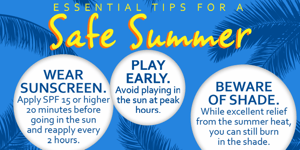Sunlight can promote the synthesis of vitamin D in the skin, and then promote the absorption of calcium in children. At the same time, sufficient outdoor light exposure can also reduce the risk of myopia in children.
But at the same time, ultraviolet rays in the sun can also cause damage to children’s skin and eyes. Ophthalmologists have already popularized the issue of wearing sunglasses to protect children’s eyes. Now I will talk about the issue of sun protection for the skin.
Do children need sun protection?
The answer is yes. Ultraviolet A (UVA) and ultraviolet B (UVB) in the sun can not only darken the skin, but also cause sunburn and solar dermatitis. Long-term sun exposure can promote skin photoaging and even increase the risk of skin cancer. Children’s skin is thinner and more sensitive to sun damage. The lesions last longer after damage exposure, so sun protection is even more important.
How to protect children from the sun?
Like adults, children mainly protect themselves from the sun in the following ways.
- Avoid peak sunshine hours
Try to go out as little as possible from 10 am to 4 pm, and try to stay in shaded areas when going out, such as under the shade of trees, under the eaves, or under a sun umbrella. - Clothing to cover up
We can give our children wide-brimmed hats that cover their face, cheeks, ears and back of the neck. For clothing, you can choose cotton or polyester, tightly woven dark loose clothing, and you can wear a long-sleeved and long-pants one-piece swimsuit when swimming outdoors. - Use sunscreen
Sunscreen is an important sun protection measure. Sun Protection Index (SPF) is an international standard for measuring the UVB protection ability of sunscreen. In daily life, you can choose sunscreen with SPF15 or above. For outdoor activities, it is recommended to choose sunscreen with SPF30 or above.
There is currently no unified index in the world to measure the UVA protection ability of sunscreen. It is recommended to choose products that are marked as broad-spectrum or that can provide protection for both UVA and UVB.
Sunscreen should be used in sufficient amount. Approximately 2 mg of sunscreen per square centimeter of skin should be applied 15-30 minutes before going out to form a protective film on the skin surface, and it should be reapplied every 2 hours.
At the same time, waterproof sunscreen is not absolutely waterproof and needs to be reapplied after sweating, swimming, or wiping the skin to ensure adequate protection.
For infants and children, it is recommended to use physical sunscreens with titanium dioxide and zinc oxide as active ingredients. It should be noted that children should avoid using spray-type sunscreens to prevent the risk of inhalation.
In addition, for babies under 6 months old, it is recommended to use physical shielding instead of sunscreen. It is recommended to use it on a small area only for parts that are not easy to block, such as the face and back of hands.
At the same time, we also need to know that even on cloudy days, if the UV index is moderate (for example, UV index is 3) or higher, sun protection measures should be taken.
Will sun protection cause calcium deficiency?
Because light can promote the synthesis of vitamin D, some people worry that using sunscreen will lead to vitamin D deficiency, which will affect the absorption of calcium. However, based on current research [1], there is no need to worry too much.
Moreover, we can supplement vitamin D orally. Infants and young children can supplement 400-600IU vitamin D3 every day to ensure the body’s needs. At the same time, if they consume an appropriate amount of milk, they don’t need to worry about calcium deficiency. Therefore, there is no need to worry about calcium deficiency caused by sun protection.
References:
[1]https://www.ncbi.nlm.nih.gov/pmc/articles/PMC6899926/




